By Nick Engelfried
By tapping into existing networks and old campaigns, a new wave of student activism is making the fossil fuel divestment movement bigger, bolder and more creative.
A wave of student-led actions swept across the campuses of around 60 U.S. and Canadian schools last month, as students turned to sit-ins, walkouts and banner drops to pressure universities into divesting their endowments from fossil fuel companies. Called “Divestment Day†by activists, the Feb. 13 series of actions was just the latest escalation for a movement that’s been undergoing a serious revival.
In fact, even just one year ago, something like the events of Divestment Day would have been unimaginable, as the movement was just coming out of a protracted lull. Since then, however, existing and newly formed divestment-focused groups have begun working together, old campaigns have adopted new tactics and the next generation of youth climate organizers has risen to the forefront.
As a result, this revitalized divestment movement is now bigger, bolder and more creative than ever before. While that’s certainly a testament to scale of the climate crisis we face — and the fact that young people are running out of patience with institutions that consistently refuse to take action — there is also a deeper story about the stabilizing role movement organizations play during periods of inaction.
Origins of the divestment movement
The nationwide fossil fuel divestment movement first took off at Swarthmore College, when students there were inspired to launch a fossil fuel divestment campaign after a 2010 visit to Appalachian communities affected by mountaintop removal mining. Previously, a scattering of student campaigns had experimented with pressuring schools to end investments in fossil fuel industries. However, while these early efforts gave climate activists valuable experience navigating the world of school investments, they were largely isolated.
PREVIOUS COVERAGE
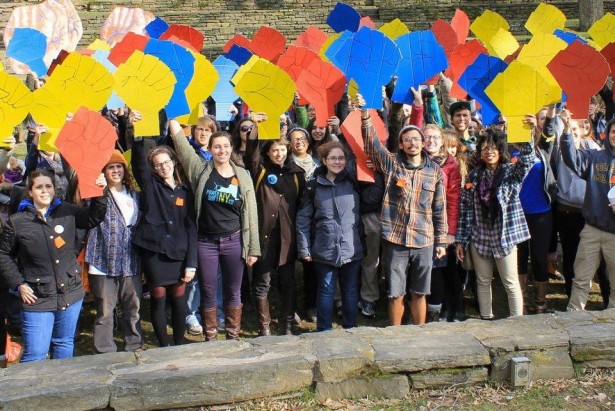
Fossil fuel divestment continues to GROW — a conversation with student organizer Kate Aronoff
The Swarthmore campaign was different. It started when national climate groups like 350.org were looking seriously at divestment as a strategy. By 2012 several other East Coast and Midwest schools — including University of North Carolina-Chapel Hill and University of Illinois — had started their own divestment campaigns. Then, later that year, 350.org held its Do The Math Tour, a nationwide series of events designed to kick the divestment movement into high gear. Within a few weeks, campaigns spread to more than 100 campuses.
Over the next few years, hundreds of churches, local governments, and philanthropic institutions started divesting from fossil fuels. However, by about 2016, the college and university arm of the movement was losing steam. It was a victim of its own success, as much of the lower-hanging fruit had already been won, with many progressive-leaning, smaller colleges already committed to divest. At other schools, administrations and boards of trustees with deep ties to the fossil fuel industry had proven themselves to be intractable.
“By 2017, a lot of campaigns had already gone through two or three rejections, and some older students were growing cynical,†said Alyssa Lee of Divest Ed, which works with divestment campaigns across the country and coordinated this month’s Divestment Day.
Lee got her start as a divestment activist at University of California Los Angeles in the movement’s early years. As a freshman, she heard visiting speakers from Tuvalu and Vanuatu describe the impact of rising sea levels on their island homelands. These stories from the frontlines inspired Lee to get involved in climate activism. At another event, hosted by the California Student Sustainability Coalition, she learned about divestment. In 2012, as the movement took off nationally, Lee helped launch a divestment campaign at UCLA.
After college Lee took a job with the Better Futures Project supporting student divestment campaigns in New England. At the time she was one of many staff spread across several organizations — including 350.org, Responsible Endowments Coalition, and Divestment Student Network — working to provide student divestment campaigns with resources. Gradually, though, most of these other groups either moved on to other priorities or dissolved.
In 2017, Lee realized she was the only staffer left in the country doing fossil fuel divestment work full-time. It seemed like a good moment to ask whether the movement had run its course, or just needed a new injection of energy to bring it fully back to life.
The following year Better Futures began a series of consultations with students and alumni from colleges where divestment campaigns were or had been organizing. “We found there were still lots of campaigns active across the country,†Lee said. “But they were generally not being noticed beyond their schools and had lost the feeling of being part of a national movement.â€
Convinced there was lots of life left in the student divestment movement after all, Better Futures launched the Divest Ed project. Bolstered by additional staff and resources, Divest Ed expanded Better Futures’ divestment work to the national level, attempting to fill the void left by other organizations.
As it turned out, the timing could hardly have been better. That coming school year was an especially propitious time to be investing in student climate organizing.
A new wave of student activism
While Divest Ed was starting up in 2018, a group of high school students coordinating over social media were launching a new youth-led climate group called Zero Hour, which debuted with a national day of marches that July. Then, as the school year began in the fall, Zero Hour along with the burgeoning international climate strike movement began inspiring hundreds of young people to become climate activists. Meanwhile, some who had already become active earlier in the year were now starting college.
PREVIOUS COVERAGE
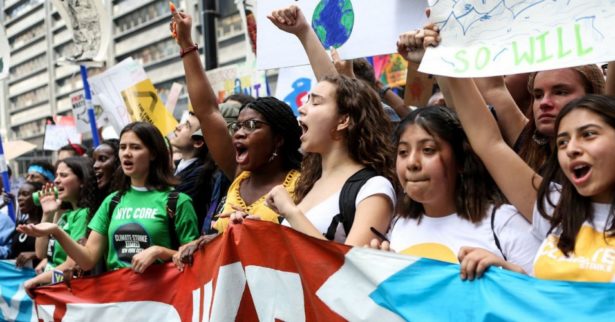
How Generation Z is leading the climate movement
“We noticed immediately, in fall of 2018, an influx of student energy around climate activism,†Lee said.
One of those students was Ilana Cohen, a New Yorker entering Harvard. Cohen traces her awareness of climate injustice to 2012, when she was 11 years old and Hurricane Sandy battered New York City. She was confused as to why she and other students in more affluent areas returned to school within days, while schools in lower-income neighborhoods remained closed for weeks after the storm. For the first time, she saw firsthand the effects of a social order where already-marginalized people are hit hardest by extreme weather and given fewer resources to cope with it.
In her senior year of high school Cohen got involved in Zero Hour, after reading about the organization online. She and a friend founded a New York chapter that coordinated a march for the first Zero Hour day of action.
On arriving at Harvard, Cohen was quickly drawn to divestment as a way to continue her activism. But the Harvard campaign, which began in 2012, had by then dwindled to only a few active members. A new cohort of activists began working to change that — including Cohen, who participated in an organizing fellowship through Divest Ed. Given that the Harvard campaign had been ongoing for years, they determined it was time to escalate.
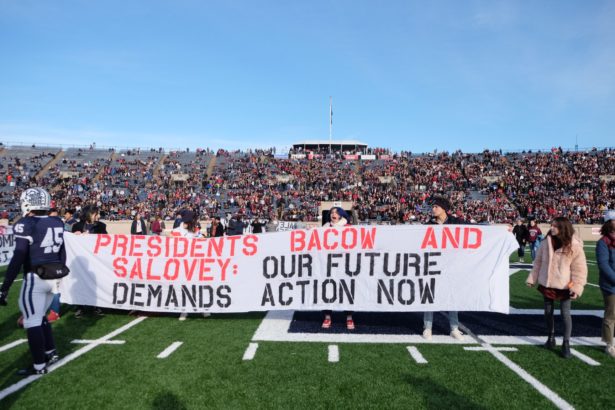
An opportunity to do so came in November 2019 at a Harvard-Yale football game. During halftime, around 150 activists from Divest Harvard, Fossil Free Yale, and Yale Endowment Justice Coalition began running to the middle of the field. As 30,000 people watched from the stands, the students unfurled banners with messages including the phrase, “Yale and Harvard are complicit in climate injustice.†Unplanned, hundreds more people from the packed stands spontaneously ran to join them until the crowd swelled to around 500.
Cohen believes the wider divestment movement will need to escalate to overcome the grip of fossil fuel interests on schools like Harvard. “Harvard-Yale is only the start of what we’ll be seeing here and at campuses around the country,†she said.
As campaigns prepare for new waves of escalation, some are turning for support not only to Divest Ed, but to a new organization committed to encouraging more direct action in the climate movement: Extinction Rebellion University.
Rebelling for climate justice
Ayisha Siddiqa was about the same age as Ilana Cohen when Hurricane Sandy brought its path of destruction to New York. But for Siddiqa’s family, living in a community of mostly black and brown immigrants on Coney Island, the effects were much longer lasting. Even today, piles of rubble and abandoned buildings attest to the power of the storm.
Siddiqa, who emigrated from Pakistan with her family when she was six, didn’t grow up hearing about the climate crisis in school. Only when she was a freshman at New York’s Hunter College, taking an ecology class, did the topic begin coming up regularly. But somehow, news that something was deeply wrong with the Earth didn’t come as a shock. “I think I was aware of it subconsciously,†Siddiqa said. Perhaps this came partly from living through events like Hurricane Sandy.
Determined to do something about the climate crisis, in May 2019 Siddiqa worked to launch Extinction Rebellion University, a student branch of the direct action movement that first made headlines by using massive crowds to shut down streets in the United Kingdom. Studying the history of social movements had impressed on her the value of nonviolent civil disobedience — but she wasn’t convinced Extinction Rebellion’s tactics in major cities were always strategic. On the other hand, college campuses seemed an ideal place to deploy nonviolent disruption for maximum effect.
“When you block traffic in a city, the only people you’re inconveniencing are those getting to and from home or work,†Siddiqa explained. “But at a university you can more easily be affecting actual decision makers. You can take over a college president’s office or board of trustees meeting.â€
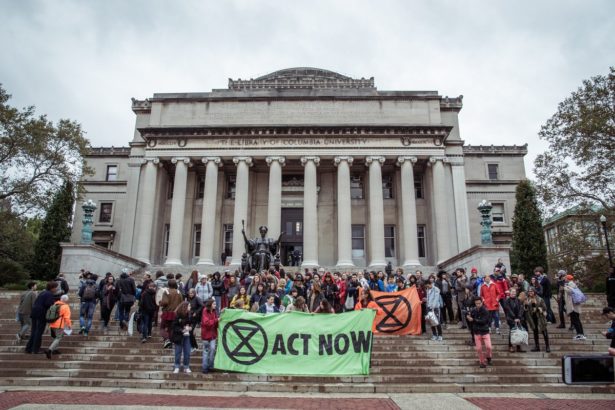
Extinction Rebellion University has held direct action trainings at more than 50 mainly Northeastern schools, some of which have already led to disruptive protests. Last fall at Columbia University, where the movement is especially strong, students organized an occupation of the library building and a week-long hunger strike with divestment as one of their demands. “We are changing the culture of civil disobedience at schools,†Siddiqa said.
The fact that such escalation has been necessary is an indicator of the resistance school administrations have presented to divestment campaigns. But while convincing major institutions to divest is almost never easy, the movement has also had recent victories.
Winning campaigns
On Feb. 6, Georgetown University’s administration announced that the Jesuit school would fully divest from all fossil fuels. For the university’s student divestment activists, it was a vindication of their years-long work.
Georgetown’s divestment campaign — Georgetown University Fossil Free, or GUFF — launched in January 2013. Early on, the campaign made use of high-visibility tactics like sit-ins, banner drops, and walking into the university board of directors’ meetings unannounced. Students got the board’s attention, prompting it to refer the fossil fuel divestment question to its Committee on Investments and Social Responsibility.
GUFF members worried the Social Responsibility Committee, which formed in response to the anti-apartheid movement decades ago, might be used to shield divestment conversations away from public view, delaying any action. But in the face of pressure from students, the committee sent a proposal to the full board that passed in 2016, committing to divest from coal. In 2018 the board voted to also divest from tar sands companies. But GUFF’s ultimate goal — full divestment from all fossil fuels — remained elusive.
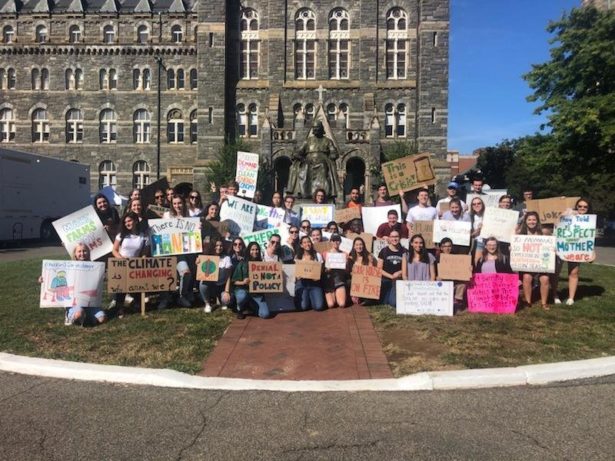
By late 2019, it seemed GUFF’s fears about the committee had been realized. Students pushed a proposal for full divestment, but committee members had largely stopped communicating. “There was radio silence for half a year,†said Sadie Morris, a GUFF member who grew up in California and transferred to GU from UC-Davis. “We got the occasional very short email saying they were looking at our proposal, but they didn’t actually seem to be meeting or moving forward.â€
GUFF members realized they needed to make the board feel more accountable to students through higher-visibility tactics. “We decided to go back to our roots and engage the student body in creating public pressure,†she said.
Eventually, Morris and other GUFF members launched a campus-wide student divestment referendum — to build support they tabled, visited classes and organized through the school’s club network. In response the Social Responsibility Committee reached out, apparently alarmed about the publicity. On the same day the student referendum vote was scheduled to take place, GU’s board of directors announced they would divest from all fossil fuels.
Supporting frontline communities
One of the campus divestment movement’s messages is that students and educational institutions must work in solidarity with people on the frontlines of climate change and fossil fuel extraction. This theme was visible on Divestment Day, when many student protests voiced support for the Wet’suwet’en people’s fight against a TransCanada fracked gas pipeline in British Columbia. Wet’suwet’en protesters at a camp in the path of the pipeline have been met with police violence and repression, in an ongoing conflict reminiscent of the fight over indigenous rights at Standing Rock.
“Divestment campaigns are highlighting how their schools are tied to companies that violate indigenous rights,†Lee said. “The key to climate justice is to restore sovereignty to tribes over their land and water.â€
Some divestment activists, like Siddiqa, have directly experienced climate change impacts in highly visceral ways. Others feel a responsibility to act from a place of privilege. “We need to mobilize our privilege as Harvard students to work on behalf of a world that is more just, ethical and sustainable,†Cohen said.
The Georgetown University victory is only one of the most recent signs that the new wave of divestment activism is proving effective. Last fall the massive University of California system committed to full divestment. Even at Harvard, where monied fossil fuel interests hold immense influence, there are signs of real momentum. Harvard faculty recently voted 179-20 to urge the school to divest, and Divest Harvard is calling for a commitment by Earth Day 2020.
Other actions are also in the works as Divest Ed and Extinction Rebellion University both plan to support escalations in the spring and fall. Meanwhile, Georgetown students are working through the Catholic Divestment Network to leverage their win by offering it as a model for other Jesuit schools.
Far from dying out, the campus fossil fuel divestment movement now has more momentum than ever, buoyed by the new wave of youth activism that inspired students like Cohen, Siddiqa and Morris to get involved.
“Divestment is just as effective as it always was, but now it’s happening against a new political backdrop,†Lee said. “It’s bringing in people at earlier ages who are already exposed to climate organizing.â€
The worsening climate crisis makes the arguments for divestment ever more compelling. “Universities’ missions are to invest in young people’s future,†Cohen said. “It’s really hard to say we’re doing that while pouring money into fossil fuel industries.â€
Nick Engelfried is an environmental writer and activist. He currently lives in the Pacific Northwest.
This article was published on March 3 at Waging Nonviolence.
